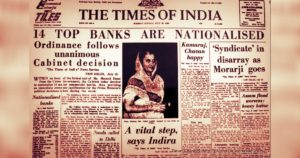19JULY 2019 STATE OBSERVER NEWS JAMMU
 As late as 9 July 1969, [PN] Haksar was not entirely convinced that banks had to be nationalised right away. Then three days later came the assault on Indira Gandhi’s authority with the announcement of Sanjiva Reddy as the Congress’s presidential candidate. Subsequently, Morarji Desai’s resignation was secured after four days.My guess is that between 12 July 1969 and 15 July 1969, Haksar and Indira Gandhi must have confabulated and decided to shed their caution on bank nationalisation. On 16 July 1969, she asked PNH to meet with KN Raj, one of India’s most distinguished economists and find out his views on bank nationalismAnother eminent economist, PN Dhar, was also present when PNH and Raj met. Dhar was to later write that Raj strongly favoured nationalisation but felt it would take at least six months to carry it out.But just three days later, on 19 July 1969, 14 banks were indeed nationalised, making one of Indira Gandhi’s “stray thoughts” an immediate reality. This account is from the memoirs of DN Ghosh, who was then the official concerned in the banking division of the Ministry of Finance and who was to later become the chairman of the State Bank of India (SBI). It was the night of 17 July 1969 and Ghosh recalls being summoned to Haksar’s residence: saw that Haksar was browsing through a mass of papers, among which I could spot the Reserve Bank publication, Statistical Tables Relating to Banks in India. He was trying to figure out how many banks accounted for 80 per cent to 85 per cent of the total resources of the system. Off the cuff, I said the number could be 10 to 12 banks.Just then, the Union Minister of State for Company Affairs, KV Raghunatha Reddy, strolled in and stood listening to our discussion. He piped up that it was a golden political opportunity to nationalise all banks and that we should go ahead with the bold decision. Haksar waived his suggestion politely and requested him to keep his impetuous radicalism to himself.Haksar wanted to be left alone till he himself had been fully briefed on a subject that was entirely foreign to him. I then asked him if the Prime Minister had made up her mind on nationalising the banks. “Not yet”, he replied. “We are to discuss this tomorrow morning.” He was not sure if it would be possible to sort out all the legal conundrums involved and have the ordinance [for nationalisation] ready by 19 July which was a Saturday. The date was crucial for two reasons. [Acting] President VV Giri was due to demit office on the forenoon of 20 July and the Lok Sabha would begin its monsoon session on 21 July.The choice of Ghosh by Haksar to be the “keeper of secrets” as far as bank nationalisation was concerned reveals much of how PNH operated.A Bakshi, who was then deputy governor of the RBI, had worked with Haksar in London in the early 1950s. They were ideologically also similar and were exceedingly close personal friends. Thanks to Haksar, Bakshi would join the soon-to-be-created department of banking in the Ministry of Finance and later become the comptroller and auditor general (C&AG) of India in 1972. It was Bakshi who had given the seal of approval to Ghosh and had joined the duo late that night of 17 July 1969 for confabulations.The next day, Ghosh writes, the prime minister herself summoned him in the morning. She wanted to be convinced that the legislative draft for nationalisation of banks could actually be prepared in less than 24 hours. When she was told that such a draft had, in fact, existed from the end of 1963 when nationalisation of five banks had first been considered, she appeared to relax and swore Ghosh to absolute secrecy saying that in case of any hitch he should apprise PNH.For the next few hours, Haksar, Bakshi, Ghosh and a few others who had been specially commandeered for this purpose, like RK Seshadri (an RBI official) and Niren De (attorney general) slogged to prepare the ordinance – which was an executive order that would have to be ratified by Parliament later.At 8.30 pm on the night of 19 July 1969, Indira Gandhi addressed the nation on radio and announced the nationalisation of banks.This was one speech of hers which had not been written or even worked upon by Haksar. Right down to the last comma and full stop, it was IG Patel’s draft. It was indeed ironic because not only was he one of Morarji Desai’s favourites, but he himself was at that time a votary of social control. In his memoirs, Patel takes some pride – and rightly so – in the authorship of this landmark speech of Indira Gandhi:I drafted the Cabinet paper and the speech for Mrs Gandhi… Not a word I wrote was changed by Haksar or Mrs Gandhi next morning…Incidentally, in the same memoirs he recalls Haksar in this fashion:What was not in doubt is that Haksar managed to concentrate enormous powers in the PM’s Secretariat and that his intellect contributed much to Mrs Gandhi’ tactics and strategies. He was accepted as Mrs Gandhi’s alter ego, and by most as Mrs Gandhi’s tutor, mentor and sole confidant…He may have been all that is rumoured. But he was very able, and in my experience mostly fair and judicious and patriotic. I also found no particular ideological obsession with him…He may have been drawn to leftists as friends and companions. But he understood the compulsions of the times and was too shrewd not to understand the weaknesses of individual leftists as well as rightists and was ready for practical compromises. If he disliked the Americans under Nixon and Kissinger, he had much reason to…IG Patel was generally considered a non-ideological, market-friendly (in today’s language) economist and, therefore, not instinctively in PNH’s orbit. But on 9 September 1969, Haksar asked Indira Gandhi to send this note to the cabinet secretary:If I recall correctly, a proposal was made last year that Dr IG Patel should become a full-fledged Secretary. I felt at that time that it was perhaps a little too early to do this. Dr Patel has now been Special Secretary for some time and I feel he deserves to be made Secretary of the Department of Economic Affairs. The Cabinet Secretary may take necessary steps.Three years later, on 6 July 1972, Haksar was to plead Patel’s case once again when a proposal had come to the prime minister that the economist leave government for a while and go as the number two man at the United Nations Development Programme (UNDP) in New York. There was some bureaucratic resistance but PNH would have none of it:Dr IG Patel is 47 years old. He has, therefore 11 more years of service left and if he is to serve India’s interest in UNDP, he should have a stake in coming back; otherwise like most Indians, his loyalty to UNDP, which would be a euphemism for self-interest, might be at the expense of India’s self-interest. Every self-respecting Government sends its high officers to UN Agencies on secondment and not for permanent absorption…IG, as he was popularly known, went to UNDP and in 1977 was made governor of the Reserve Bank of India by Indira Gandhi’s successor Morarji Desai. He was later to be PV Narasimha Rao’s first choice as finance minister in 1991, and only when he had declined was the job offered to Dr Manmohan Singh
As late as 9 July 1969, [PN] Haksar was not entirely convinced that banks had to be nationalised right away. Then three days later came the assault on Indira Gandhi’s authority with the announcement of Sanjiva Reddy as the Congress’s presidential candidate. Subsequently, Morarji Desai’s resignation was secured after four days.My guess is that between 12 July 1969 and 15 July 1969, Haksar and Indira Gandhi must have confabulated and decided to shed their caution on bank nationalisation. On 16 July 1969, she asked PNH to meet with KN Raj, one of India’s most distinguished economists and find out his views on bank nationalismAnother eminent economist, PN Dhar, was also present when PNH and Raj met. Dhar was to later write that Raj strongly favoured nationalisation but felt it would take at least six months to carry it out.But just three days later, on 19 July 1969, 14 banks were indeed nationalised, making one of Indira Gandhi’s “stray thoughts” an immediate reality. This account is from the memoirs of DN Ghosh, who was then the official concerned in the banking division of the Ministry of Finance and who was to later become the chairman of the State Bank of India (SBI). It was the night of 17 July 1969 and Ghosh recalls being summoned to Haksar’s residence: saw that Haksar was browsing through a mass of papers, among which I could spot the Reserve Bank publication, Statistical Tables Relating to Banks in India. He was trying to figure out how many banks accounted for 80 per cent to 85 per cent of the total resources of the system. Off the cuff, I said the number could be 10 to 12 banks.Just then, the Union Minister of State for Company Affairs, KV Raghunatha Reddy, strolled in and stood listening to our discussion. He piped up that it was a golden political opportunity to nationalise all banks and that we should go ahead with the bold decision. Haksar waived his suggestion politely and requested him to keep his impetuous radicalism to himself.Haksar wanted to be left alone till he himself had been fully briefed on a subject that was entirely foreign to him. I then asked him if the Prime Minister had made up her mind on nationalising the banks. “Not yet”, he replied. “We are to discuss this tomorrow morning.” He was not sure if it would be possible to sort out all the legal conundrums involved and have the ordinance [for nationalisation] ready by 19 July which was a Saturday. The date was crucial for two reasons. [Acting] President VV Giri was due to demit office on the forenoon of 20 July and the Lok Sabha would begin its monsoon session on 21 July.The choice of Ghosh by Haksar to be the “keeper of secrets” as far as bank nationalisation was concerned reveals much of how PNH operated.A Bakshi, who was then deputy governor of the RBI, had worked with Haksar in London in the early 1950s. They were ideologically also similar and were exceedingly close personal friends. Thanks to Haksar, Bakshi would join the soon-to-be-created department of banking in the Ministry of Finance and later become the comptroller and auditor general (C&AG) of India in 1972. It was Bakshi who had given the seal of approval to Ghosh and had joined the duo late that night of 17 July 1969 for confabulations.The next day, Ghosh writes, the prime minister herself summoned him in the morning. She wanted to be convinced that the legislative draft for nationalisation of banks could actually be prepared in less than 24 hours. When she was told that such a draft had, in fact, existed from the end of 1963 when nationalisation of five banks had first been considered, she appeared to relax and swore Ghosh to absolute secrecy saying that in case of any hitch he should apprise PNH.For the next few hours, Haksar, Bakshi, Ghosh and a few others who had been specially commandeered for this purpose, like RK Seshadri (an RBI official) and Niren De (attorney general) slogged to prepare the ordinance – which was an executive order that would have to be ratified by Parliament later.At 8.30 pm on the night of 19 July 1969, Indira Gandhi addressed the nation on radio and announced the nationalisation of banks.This was one speech of hers which had not been written or even worked upon by Haksar. Right down to the last comma and full stop, it was IG Patel’s draft. It was indeed ironic because not only was he one of Morarji Desai’s favourites, but he himself was at that time a votary of social control. In his memoirs, Patel takes some pride – and rightly so – in the authorship of this landmark speech of Indira Gandhi:I drafted the Cabinet paper and the speech for Mrs Gandhi… Not a word I wrote was changed by Haksar or Mrs Gandhi next morning…Incidentally, in the same memoirs he recalls Haksar in this fashion:What was not in doubt is that Haksar managed to concentrate enormous powers in the PM’s Secretariat and that his intellect contributed much to Mrs Gandhi’ tactics and strategies. He was accepted as Mrs Gandhi’s alter ego, and by most as Mrs Gandhi’s tutor, mentor and sole confidant…He may have been all that is rumoured. But he was very able, and in my experience mostly fair and judicious and patriotic. I also found no particular ideological obsession with him…He may have been drawn to leftists as friends and companions. But he understood the compulsions of the times and was too shrewd not to understand the weaknesses of individual leftists as well as rightists and was ready for practical compromises. If he disliked the Americans under Nixon and Kissinger, he had much reason to…IG Patel was generally considered a non-ideological, market-friendly (in today’s language) economist and, therefore, not instinctively in PNH’s orbit. But on 9 September 1969, Haksar asked Indira Gandhi to send this note to the cabinet secretary:If I recall correctly, a proposal was made last year that Dr IG Patel should become a full-fledged Secretary. I felt at that time that it was perhaps a little too early to do this. Dr Patel has now been Special Secretary for some time and I feel he deserves to be made Secretary of the Department of Economic Affairs. The Cabinet Secretary may take necessary steps.Three years later, on 6 July 1972, Haksar was to plead Patel’s case once again when a proposal had come to the prime minister that the economist leave government for a while and go as the number two man at the United Nations Development Programme (UNDP) in New York. There was some bureaucratic resistance but PNH would have none of it:Dr IG Patel is 47 years old. He has, therefore 11 more years of service left and if he is to serve India’s interest in UNDP, he should have a stake in coming back; otherwise like most Indians, his loyalty to UNDP, which would be a euphemism for self-interest, might be at the expense of India’s self-interest. Every self-respecting Government sends its high officers to UN Agencies on secondment and not for permanent absorption…IG, as he was popularly known, went to UNDP and in 1977 was made governor of the Reserve Bank of India by Indira Gandhi’s successor Morarji Desai. He was later to be PV Narasimha Rao’s first choice as finance minister in 1991, and only when he had declined was the job offered to Dr Manmohan Singh


